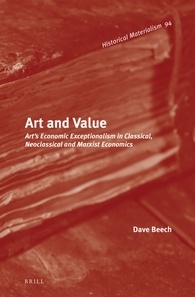Dave Beech, Chelsea College of Art
Art and Value is the first comprehensive analysis of art’s political economy throughout classical, neoclassical and Marxist economics. It provides a critical-historical survey of the theories of art’s economic exceptionalism, of art as a merit good, and of the theories of art’s commodification, the culture industry and real subsumption.
Key debates on the economics of art, from the high prices artworks fetch at auction, to the controversies over public subsidy of the arts, the ‘cost disease’ of artistic production, and neoliberal and post-Marxist theories of art’s incorporation into capitalism, are examined in detail.
Subjecting mainstream and Marxist theories of art’s economics to an exacting critique, the book concludes with a new Marxist theory of art’s economic exceptionalism.
Biographical note
Dave Beech is an artist in the collective Freee and teaches Fine Art at Chelsea College of Art. His work has been exhibited at the Liverpool Biennial (2010) and the Istanbul Biennial (2013). He has co-authored The Philistine Controversy (Verso, 2002), edited Beauty (MIT/Whitechapel, 2009), contributed essays to Locating the Producers (Valiz, 2011), and Curating and the Educational Turn (Open Editions, 2010).
Readership
All interested in Marx scholarship, cultural economics, the politics of art, the history of economic thought, theories of art’s relationship to capitalism, and Marxist theories of art.
Reviews
Has art been commodified? Has artistic production been subsumed under capital? These and similar notions have become commonplace in both mainstream and Marxist discourse, but Dave Beech argues for art’s exceptionalism. Eschewing facile totalizations, he makes some much-needed theoretical distinctions rooted in Marx’s work, and highlights anomalies and details. He is definitely asking the right questions.
– Andrew Kliman is an economist and Professor in economics at Pace University, New York.
We’re all looking for an opening. Dave Beech has put his hand on a key hidden for decades under a mountain of gloom. The result is Art and Value. I’ve never read anything like it. It is a precisely argued critique of the pessimistic Marxist orthodoxy about the fatal dissolution of art into the commodity form, carried out in terms closely derived from Marx’s own writings and brought forward through history from the origins of modern economics to the present moment. In meticulous detail, Beech demonstrates how works of art are ‘economically exceptional’: that they are not in fact produced as commodities but only come into relation with the commodity form in ways that are not eternal, necessary, and incurable, but social, changeable, and even insignificant. It opens an authentically new dimension in this long debate and, in doing so, shows us a model of artistic, and by extension, social and political freedom that can inspire hope, confidence, and daring. This is a book of, and for, high spirits.
– Jeff Wall is an artist known for pioneering post-conceptual photography and critical writing on art history.
Table of contents
Acknowledgements
Introduction
PART ONE
1. Art, Value and Economics
2. Art and Exceptionalism in Classical Economics
3. Art and Exceptionalism in Neoclassical Economics
4. Exceptionalism After 1945
5. Exceptionalism After 1966
6. Exceptionalism Reassessed
PART TWO
7. On the Absence of a Marxist Economics of Art
8. Art and Productive Capital
9. Art and Merchant Capital
10. Art and Finance Capital
11. Art and Post-Fordism
Conclusion
Bibliography
Index

